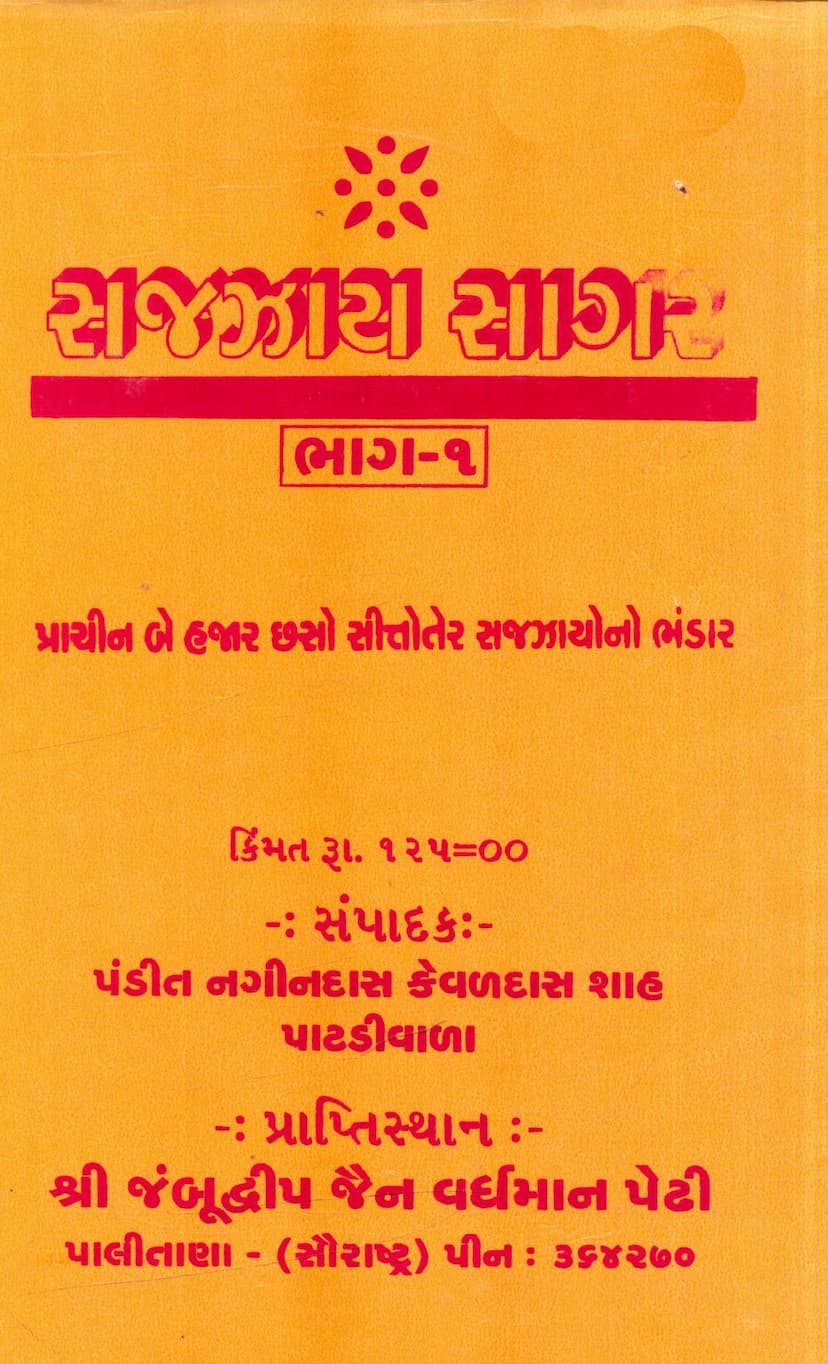Sazzay Sagar Part 01
Added to library: September 2, 2025

Summary
This Jain text, "Sazzay Sagar Part 01" by Nagindas Kevaldas Shah, published by Sushilaben Shah, is a vast collection of "Sazzays" (religious verses or songs) that likely originate from a tradition of devotional Jain literature.
Based on the provided pages, here's a comprehensive summary:
Title and Author:
- Book Title: Sazzay Sagar Part 01 (સજઝાય સાગર ભાગ-૧)
- Author: Nagindas Kevaldas Shah (નગીનદાસ કેવળદાસ શાહ) - referred to as Pandit Nagindas Kevaldas Shah (પંડીત નગીનદાસ કેવળદાસ શાહ).
- Publisher: Sushilaben Shah (સુશીલાબેન શાહ).
- Catalog Link: https://jainqq.org/explore/034187/1
Nature of the Work:
- The title itself, "Sazzay Sagar," meaning "Ocean of Sazzays," and the subtitle "Ancient repository of sixteen hundred and seventy-three Sazzays" (પ્રાચીન હજાર છસો સીત્તોતેર સજઝાયોનો ભંડાર), clearly indicates that this is a compilation of devotional verses, likely covering a wide range of Jain philosophical, ethical, and biographical themes.
- The text appears to be a collection of these verses, organized thematically and/or alphabetically, as evidenced by the extensive index starting from page 11.
Content and Themes: The index (granthasuchi - ગ્રંથસૂચી) reveals a remarkably diverse range of topics covered within the Sazzays. These include:
- Praise and Homage: Dedications and salutations to spiritual teachers and revered figures like Shri Abhay Sagarji Ganivareśya (શ્રી અભય સાગરજી ગણિવરેસ્યા) and Shri Dharm Sagarji Upadhyay (શ્રી ધમ સાગરજી ઉપાધ્યાયેભ્યે).
- Jain Philosophy and Principles:
- The Mahima of Swadhyaya (સ્વાધ્યાયની મહત્તા): The importance of self-study and its role in detachment (vairagya) and spiritual progress.
- Virtues and Vows: Sazzays on various virtues like compassion (anukampadan), forgiveness (kshama), and the observance of vows (vrata).
- Core Jain Concepts: Discussions on karma, the nature of the soul (atma), attachment (raag), aversion (dwesh), the cycle of birth and death (chatur gati), and the path to liberation (moksha).
- Ethical Teachings: Sazzays addressing negative qualities like pride (abhiman), anger (krodh), greed (lobh), and the consequences of these.
- Biographies and Narratives: Numerous Sazzays recount the lives and stories of:
- Jain Tirthankaras and Acharyas: Mention of Adi Nath (આદિનાથ), Arihant (અરિહંત), and various historical monks and ascetics like Aimuṭṭa Muni (અઈમુત્તા મુનિ), Avanti Sukumal (અવંતિ સુકુમાલ), and Dhanna ShAlibhadra (ધન શાલિભદ્ર).
- Renowned Devotees: Stories of devout individuals, both male and female, like Anantakay (અનંતકાય), Amukā Satī (અમકા સતી), Amarkumar (અમર કુમાર), and many others, highlighting their spiritual journeys and adherence to principles.
- Illustrative Stories: Narratives of spiritual discipline, overcoming obstacles (upasarga), and achieving liberation.
- Specific Jain Texts and Concepts: References to Jain scriptures like Āchārānga Sūtra (આચારાંગ સૂત્ર), Sūyagaḍānga Sūtra (સૂયગડાંગ સૂત્ર), Thāṇānga Sūtra (ઠાણાંગ સૂત્ર), Bhagavati Sūtra (ભગવતી સૂત્ર), Gñātādharmakathāṅga Sūtra (જ્ઞાતાધર્મકથા), and Upāsaka Daśā Sūtra (ઉપાસક દશા સૂત્ર). There are also Sazzays on the eleven Angas (અગ) and twelve Upangas (ઉપાંગ) of Jain scripture.
- Practices and Rituals: Mention of specific practices like fasting (aayambila - આયંબિલ), meditation (dhyana), and the importance of reciting mantras (e.g., Navkar mantra).
- The Four States of Existence: Discussions on the cycle of births and deaths across different realms.
- The Nature of Reality: Exploration of concepts like impermanence (anitya), non-attachment (vairagya), and the soul's inherent purity.
- The Importance of the Human Birth: Emphasizing the rarity and value of this life for spiritual progress.
- The Do's and Don'ts: Sazzays detailing forbidden actions (abhakshya - અભક્ષ્ય) and vices (e.g., alcohol, opium).
- The Role of the Guru: Highlighting the guidance and importance of a spiritual teacher.
- The Power of Faith and Devotion: Stories illustrating the transformative power of sincere devotion.
Structure and Organization:
- The book is organized thematically and, as seen in the index, likely alphabetically by the first letter of the Sazzay's topic or title, facilitating easy access.
- There are cross-references within the index, indicating connections between different Sazzays.
- The presence of indices for Sazzays related to specific scriptures (like the Angas and Upangas) suggests a structured approach to the compilation.
Dedication and Acknowledgements:
- The book is dedicated to Pujya Pad Shri Gurudev Shri Abhayasārajī (પૂજ્ય પાદ પં. ગુરૂદેવ શ્રી અભયસારજી) and Pujya Paḍ Gachchādhipati Shri Süryoday Sā. Sū. Ma. Sahe. (પૂજ્ય પાદ ગચ્છાધિપતિ શ્રી સૂર્યોદય સા. સૂ. મ. સાહેબ), commemorating the occasion of their ascension to Acharya pada (આચાર્ય પદ પ્રદાન) in 2052 V.S. (Samvat) at Jambudvip, Palitana.
- The author/compiler expresses gratitude to their wife for constant encouragement and mentions receiving blessings and guidance from numerous revered spiritual figures who played a role in their spiritual and intellectual development.
- A key principle highlighted in the dedication is the importance of utilizing wealth for good deeds, as expressed by the verse: "The fruit of action is wealth, the fruit of wealth is a worthy recipient, and through that, this life becomes meaningful. However, even after obtaining wealth, if it is not spent on good deeds, it is called wasted, meaning the rare human birth is lost." (વ્યવસાયફલં વિહવો વિહવસ્સ ફલં સુપાત્રવિણિલઓ । તયભાએ વવસાયો વિહવો ય દુંગ્ગઇનિમિત્તં ॥).
Overall Significance: "Sazzay Sagar Part 01" appears to be a foundational text for Jain devotional practice, offering a rich tapestry of spiritual knowledge, ethical guidance, and inspiring life stories through the medium of Sazzays. The sheer volume of Sazzays indicates a deep and long-standing tradition of this form of literature within Jainism. The compiler's dedication also points to the importance of lineage and the continuity of spiritual teachings.